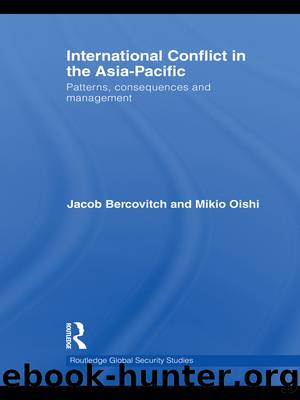International Conflict in the Asia-Pacific by Jacob Bercovitch Mikio Oishi

Author:Jacob Bercovitch, Mikio Oishi [Jacob Bercovitch, Mikio Oishi]
Language: eng
Format: epub
Tags: History, Asia, General, Military, Political Science, International Relations, Diplomacy, Security (National & International)
ISBN: 9781136938801
Google: 8xbJBQAAQBAJ
Publisher: Routledge
Published: 2010-06-23T01:15:55+00:00
Process to manage the Spratly Islands dispute
The previous section identified the three goals for the management of the Spratly Islands dispute. This section examines how these goals have been pursued in several management processes initiated by claimants and/or concerned parties. It also looks at how China has changed and adjusted its original position on the dispute by participating in these processes.
Track Two workshop series
The series of workshops entitled âManaging Potential Conflicts in the South China Seaâ is the first peace initiative to address the Spratly Islands dispute. This process was initiated by Indonesia in 1990; reflecting ASEANâs concern with the rising tension in the Spratlys, particularly in the aftermath of the Sino-Vietnam naval clash in 1988. Indonesia was well qualified for hosting the initiative. It was not only a third party to the Spratly Islands dispute, but also it had recently played a major role in the settlement of the Cambodian Civil War.
There were several reasons why the first peace initiative for the dispute was Track Two, that is, of a private nature. First, a Track Two process was easier to start than an official Track One process. Because of the unbinding nature of its decisions, Track Two is usually more acceptable to the disputants than Track One, at least in the initial phases of a peace process. Second, the organisers had to weigh up between the need to hold multilateral meetings and Chinaâs objection to them. It was considered essential that all the six claimants to the Spratly Islands be represented in the workshops. Particularly important was the participation of China, the most aggressive player among the claimants. However, it was known that China did not want to discuss the dispute in a multilateral framework for fear of losing the advantage that it enjoyed in bilateral dialogues. Therefore, it was expected that the unofficial multilateralism that the Track Two workshops would provide be more acceptable to China than the official multilateralism of Track One. Third, Track Two was the only process in which Taiwan could participate without causing objections from China. The latter would be determined to prevent the former from being officially accorded an international status.
A basic feature of a Track Two process is that the participants attend the meetings as âprivate personsâ, although they are often senior government officials from respective states. This arrangement would relieve the attendants from the restrictions and inflexibility of official meetings and encourage them to freely explore issues of mutual concern. It is also expected that the mutual understanding and goodwill generated from the process would positively affect the behaviour of the claimants. Moreover, in the Spratly Islands dispute, the participation of Chinese representatives in the Track Two process would open the opportunity for those from other states to better understand Chinaâs claims and objectives.
The first workshop was held in Bali in 1990. For the purpose of laying down the groundwork, only participants from ASEAN countries were invited to the meeting. From the second workshop in Bandung onward, not only ASEAN but also non-ASEAN claimants sent representatives to the workshops.
Download
This site does not store any files on its server. We only index and link to content provided by other sites. Please contact the content providers to delete copyright contents if any and email us, we'll remove relevant links or contents immediately.
| Africa | Americas |
| Arctic & Antarctica | Asia |
| Australia & Oceania | Europe |
| Middle East | Russia |
| United States | World |
| Ancient Civilizations | Military |
| Historical Study & Educational Resources |
Machine Learning at Scale with H2O by Gregory Keys | David Whiting(4183)
Never by Ken Follett(3794)
Fairy Tale by Stephen King(3220)
The Man Who Died Twice by Richard Osman(2997)
Oathbringer (The Stormlight Archive, Book 3) by Brandon Sanderson(2886)
Will by Will Smith(2793)
Rationality by Steven Pinker(2291)
The Dark Hours by Michael Connelly(2245)
Can't Hurt Me: Master Your Mind and Defy the Odds - Clean Edition by David Goggins(2228)
The Dawn of Everything: A New History of Humanity by David Graeber & David Wengrow(2122)
Friends, Lovers, and the Big Terrible Thing by Matthew Perry(2119)
Principles for Dealing With the Changing World Order: Why Nations Succeed and Fail by Ray Dalio(1974)
HBR's 10 Must Reads 2022 by Harvard Business Review(1777)
A Short History of War by Jeremy Black(1762)
Go Tell the Bees That I Am Gone by Diana Gabaldon(1687)
515945210 by Unknown(1599)
A Game of Thrones (The Illustrated Edition) by George R. R. Martin(1589)
Kingdom of Ash by Maas Sarah J(1527)
443319537 by Unknown(1470)
